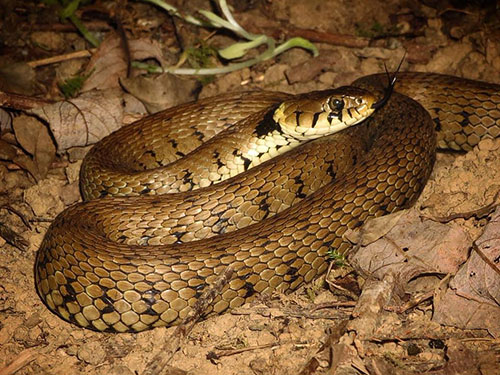


Large Grass Snake at Waterhall
Photo: Ryan Greaves

A rare melanistic Grass Snake
Photo: Rachel Bicker
It was as recently as 2017 that Britain’s largest reptile, the Grass Snake, was recognised as a distinct species, previously Natrix natrix subsp. helvetica, now Natrix helvetica. Adult Grass Snakes can grow to over a metre in length and weigh up to 0.25kg. Probably the commonest species of snake and the most likely to be encountered as it sometimes frequents gardens, sheltering in compost heaps.
Grass Snakes usually hibernate among tree roots, animal burrows or other underground location that is not susceptible to waterlogging. It is on the warmer days in March when Grass Snakes may first be seen after emerging from these hibernacula sites. The main habitats for the species, at this time of year, are aquatic; ponds and lakes, ditches and slow flowing rivers which are well vegetated at their perimeters. The snakes avoid more open areas as this makes them vulnerable to predation. Excellent swimmers, their main prey in the spring are small fish and amphibians. However, as the year moves on and their amphibian prey moves out of the water to the terrestrial phase of their lifecycle so do Grass Snakes, dispersing into a range of usually woodland habitats where they continue to feed on frogs and toads as well as occasionally other prey such as small rodents and ground-nesting bird chicks.
Mating takes place shortly after emergence on warmer days and this often takes the form of a ‘mating ball’ where up to eight males entwine themselves around and attempt to mate with one or two females. The ball can persist for a couple of hours and the male that successfully mates is decided, seemingly, more by luck than any other factor. These mating balls have been observed among the reeds at the far end of the pond at SWT’s Woods Mill reserve. After mating the females will lay usually about 20 eggs in rotting vegetation and often garden compost heaps. The juveniles emerge in early autumn and will start to feed on small prey before commencing hibernation during October.
Grass Snakes are distinctively marked, with a black and yellow or cream-coloured collar, a usually dark green upper surface and pale underside, making them easy to identify. Occasionally melanistic specimens are seen but these are rare. All records of this species (and all other reptiles) are very welcome and will help to further our understanding of the ecology of the species. If you are lucky enough to see this beautiful animal, please submit your observations to iRecord ideally with a photo.
Every month it is our aim to highlight a species that is “in-season” and, although not necessarily rare or difficult to identify, has been highlighted by our local recording groups as being somewhat under-recorded and for which new records would therefore be welcomed.
If you or your recording group are aware of species such as this then please contact Bob Foreman.